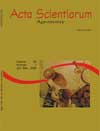<b>Induction of rooting in cuttings of <em>Malvaviscus arboreus</em> Cav. with different concentrations of Indolbutiric Acid (IBA)</b> - DOI: 10.4025/actasciagron.v31i2.799
Keywords:
Malvaceae, propagation, growth regulator
Abstract
The study evaluated the effect of three concentrations of auxin (0; 2,000 and 6,000 ppm) (indolbutiric acid - IBA) in inducing the formation of adventitious roots in three types of stem stakes (herbaceous, woody and semi-woody) of wax mallow (Malvaviscus arboreus Cav.). The stakes were cut into a bezel angle, with approximately 12 cm each, treated with the fungicide Benlate and later with IBA. The assessments were made 30 days after planting, evaluating the appearance or absence of calluses, roots and shoots. Among the stakes, the woody ones showed the best regenerative capacity, reaching the maximum corpus callosum, rooting and shooting, regardless of IBA concentration. In the treatment with 2000 ppm IBA concentration, herbaceous and woody stakes showed the best results for rooting.Downloads
Download data is not yet available.
Published
2009-05-14
How to Cite
Loss, A., Teixeira, M. B., Santos, T. de J., Gomes, V. M., & Queiroz, L. H. (2009). <b>Induction of rooting in cuttings of <em>Malvaviscus arboreus</em> Cav. with different concentrations of Indolbutiric Acid (IBA)</b> - DOI: 10.4025/actasciagron.v31i2.799. Acta Scientiarum. Agronomy, 31(2), 269-273. https://doi.org/10.4025/actasciagron.v31i2.799
Issue
Section
Crop Production
DECLARATION OF ORIGINALITY AND COPYRIGHTS
I Declare that current article is original and has not been submitted for publication, in part or in whole, to any other national or international journal.
The copyrights belong exclusively to the authors. Published content is licensed under Creative Commons Attribution 4.0 (CC BY 4.0) guidelines, which allows sharing (copy and distribution of the material in any medium or format) and adaptation (remix, transform, and build upon the material) for any purpose, even commercially, under the terms of attribution.
2.0
2019CiteScore
60th percentile
Powered by 

2.0
2019CiteScore
60th percentile
Powered by 



















































